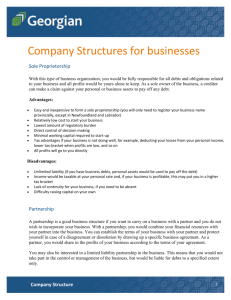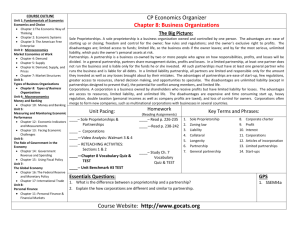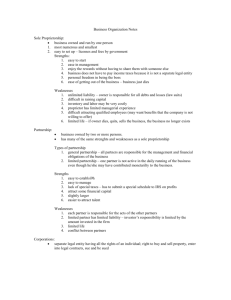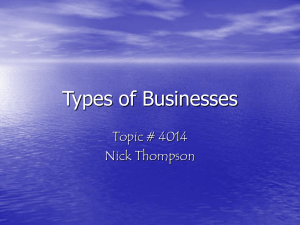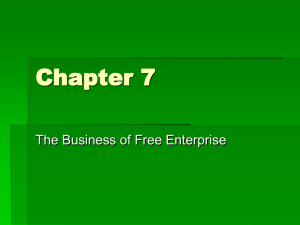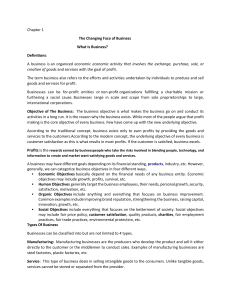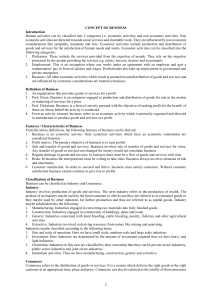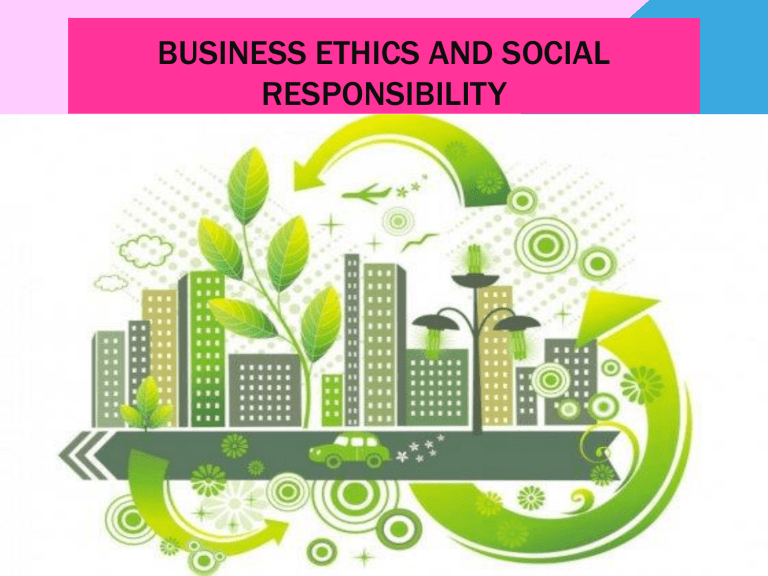
BUSINESS ETHICS AND SOCIAL RESPONSIBILITY NATURE OF BUSINESS ORGANIZATION BUSINESS ORGANIZATION: AN ART OR A SCIENCE Business organization – Art ART is a system of rules for the attainment of a given end. Thomas L. Massie says, “In any activity that is classed as an art the emphasis is on applying skills and knowledge in accomplishing an end through deliberate effort. George Robert Terry, art is “bringing about of a desired result through application of skill.” Chester Irving Barnard has remarked. “The function of an art is to accomplish concrete ends, effect result, produce situations that would not come about, without the deliberate effort to secure them.” Art, thus, concerned with the application of skills and knowledge. In this sense, business organization is an art as one has to use his skills and knowledge in solving many complicated problems of business to achieve the enterprise objectives. Business organization – Science SCIENCE literally means knowledge. It is a systematized body of knowledge acquired by mankind through observation and experimentation and which is capable of verification. John Maynard Keynes , “science is a systematized body of knowledge which establishes relationship between cause and effect.” Business organization is viewed as a science as it is an organized body of knowledge built up by management practitioners, thinkers and philosophers over a period of years. What is the meaning of Business – is a commercial enterprise which is operated of making profit by supplying goods and services to consumers. What is an Organization? Organization - is an organized body of people with a particular purpose especially a business, society, association, etc. Business Organization – is the structure of a specific entity in terms of how its formed and functions in the society, the structure of the organization is built on the purpose of the business. Business Organizations come in different types and different forms of ownership MAJOR TYPES OF BUSINESSES 1. Service Business 2. Merchandising Business 3. Manufacturing Business 1. Service Business – a service type of business that provides intangible products (products with no physical form). Service firms offer professional skills, expertise, advice and other similar products. 2. Merchandising Business – this types of business buys products at wholesale price and sells the same at retail price. They are known as “buy and sell” businesses. They make profit by selling the products at prices higher than their purchase costs. 3. Manufacturing Business – unlike a merchandising business, a manufacturing business buys products with the intention of using them as materials in making a new products. There is a transformation of the products purchased. FORMS OF BUSINESS ORGANIZATION 1. Sole Proprietorship 2. Partnership 3. Limited Partnership 4. Corporation 1. Sole Proprietorship – is a business owned by only one person. It is easy to set up and is the least costly among all forms of ownership. ADVANTAGES Easy/Inexpensive to form You set your own hours Take in all the profit., profits go to the owner Direct Control of the business, you are your own boss Easy to dissolve DISADVANTAGES Limited financing Limited ideas The sole proprietor is responsible for all losses The sole proprietor faces unlimited liabilities 2. Partnership – is a business owned by two or more persons who contribute resources into the entity. The partners divide the profits of the business among themselves. Most partnerships should have a “partnership agreement” because of the potential issues between the partners. ADVANTAGES The ability to raise more money, usually more access to capital More potential for ideas and innovation The ability to share workload among all of the partners The ability to divide losses among all of the partners DISADVANTAGES The potential for disagreements about how to run a business Profits must be split among all of the partners Partnership face unlimited liability Mutual agency : all of the partners have the authority to conduct a business on behalf of the partnership 3. Limited Partnership – this is a variation on the general partnership form of business organization. There are two types of partners, general and limited. The limited partners invest money and share profits and losses. The limited partners only face limited liability. 4. Corporations - a business organization that has a separate legal entity. The most complex type of business organization. Permanent organization and treated as individuals. Has rights and responsibilities. ADVANTAGES Limited Liability –corporation not owners are responsible for debts Easy to raise money *selling stock in company (share of ownership) *profits paid to stockholder (dividends) Disadvantages Limited say in running the company Elected Directors * Elected by shareholders * Directors choose executives to run the company
